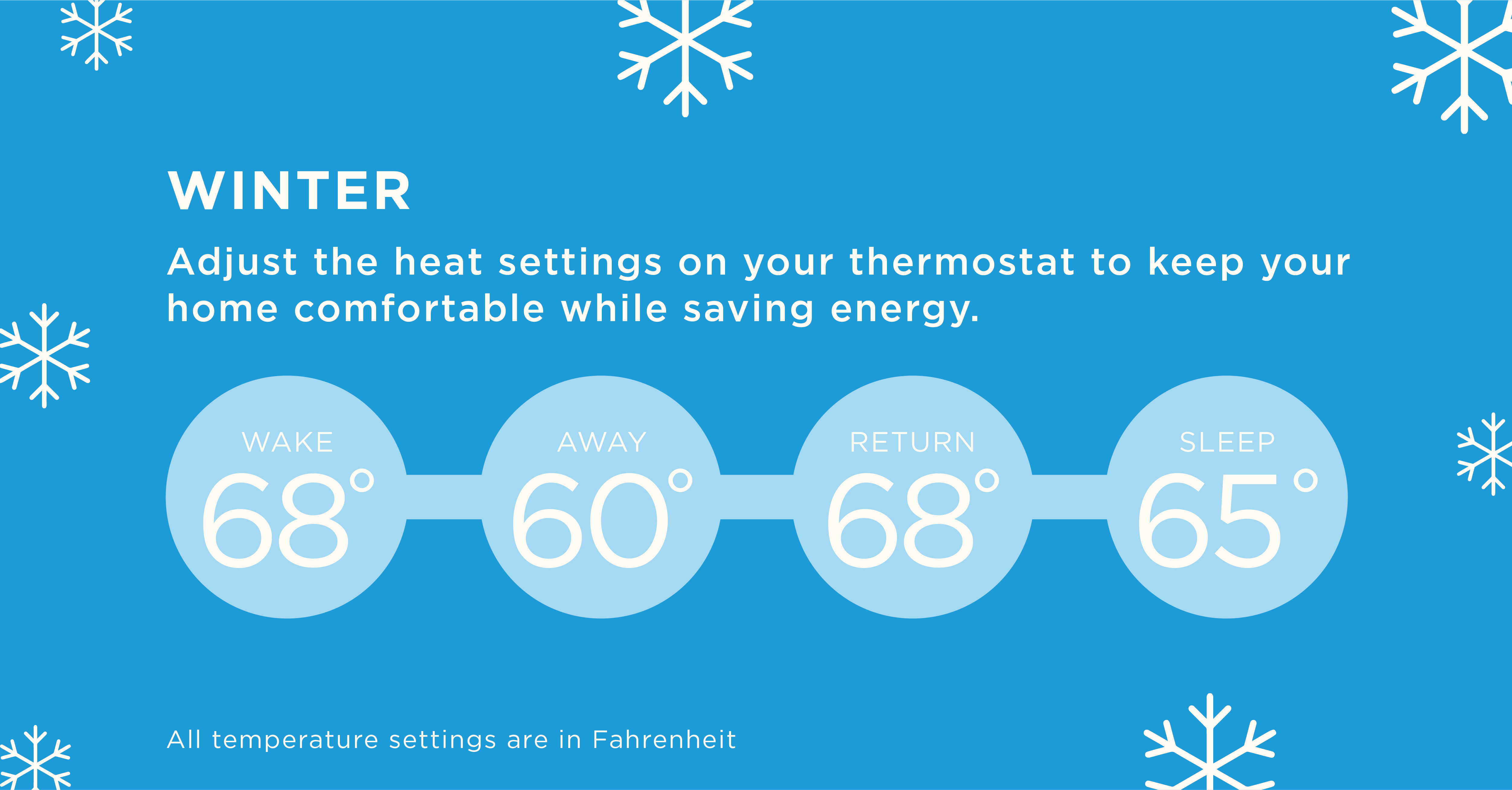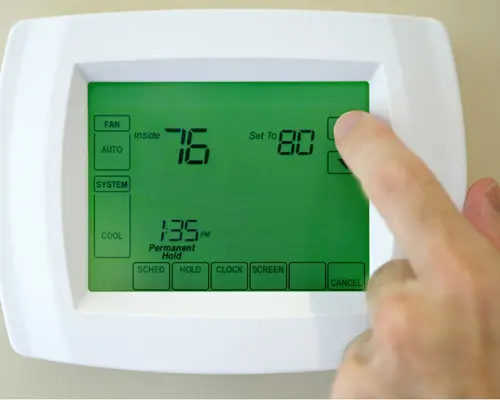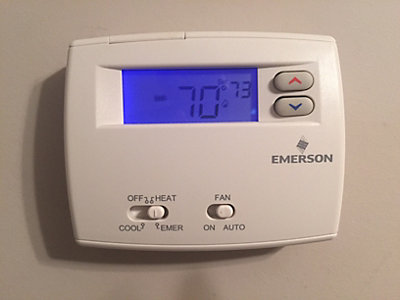Check Best Thermostat Pricing in Amazon
** As an Amazon Associate, I earn from qualifying purchases.
Set your thermostat to 68 degrees Fahrenheit in the winter. Lowering it at night or when away can save money.
Winter brings chilly days and colder nights. Keeping your home warm while saving on energy bills is a common concern. Finding the best thermostat setting can make a big difference in comfort and costs. The ideal temperature varies based on personal preference, insulation, and heating systems.
Understanding the balance between warmth and energy efficiency can help you find the perfect setting. In this blog, we’ll explore the best practices for setting your thermostat during the winter months. You’ll learn how to stay cozy without breaking the bank. Let’s dive into the details and find the best temperature for your home this winter.
Optimal Winter Thermostat Settings
Setting your thermostat to the right temperature during winter can save energy and money. It also keeps your home comfortable. Finding that perfect balance is key. Here, we discuss the optimal winter thermostat settings to help you achieve this balance.
Ideal Temperature Range
The ideal temperature range for winter is 68 to 72 degrees Fahrenheit. During the day, keeping your thermostat at 68 degrees can help save energy. At night, you can lower it to 60-62 degrees. This setting helps reduce heating costs while you sleep. If you feel cold, use extra blankets or wear warmer clothes.
Factors Affecting Settings
Several factors can affect your thermostat settings. The size of your home is one. Larger homes may need more heat. The insulation quality of your home is another. Well-insulated homes retain heat better. The type of heating system also matters. Some systems heat faster than others.
Your personal comfort level is also important. Some people prefer warmer temperatures. Others might be fine with cooler settings. Health conditions can also play a role. Older adults or young children may need warmer temperatures. Adjust your thermostat to meet your family’s needs.

Credit: www.scanaenergy.com
Energy Efficiency Tips
Keeping your home warm during winter can be costly. Fortunately, there are effective ways to manage your thermostat settings. These energy efficiency tips will help you save money and stay comfortable.
Nighttime Adjustments
Lowering the thermostat at night can reduce energy use. Set it to 60-67 degrees Fahrenheit while you sleep. This range keeps you warm and saves on heating costs. Use extra blankets or a warm duvet for added comfort.
Using Programmable Thermostats
Programmable thermostats are a smart choice for energy savings. You can set different temperatures for various times of the day. For example, lower the heat when no one is home. Set it to warm up just before you return. This ensures comfort without wasting energy.
Balancing Comfort And Cost
Set your thermostat to 68°F in winter for a cozy home and lower energy bills. Adjust slightly for personal comfort.
Balancing comfort and cost during winter can be challenging. You want to stay warm without your utility bills skyrocketing. Fortunately, there are practical ways to find the right balance.Finding The Sweet Spot
Setting your thermostat to the right temperature can make a huge difference. The U.S. Department of Energy recommends setting your thermostat to 68 degrees Fahrenheit when you’re awake and lowering it when you’re asleep or away from home. This temperature keeps your home comfortable while saving energy. If 68 degrees feels too chilly, consider wearing a sweater or using a blanket. Small adjustments can make a big difference without compromising comfort.Managing Utility Bills
Utility bills can be a concern for many during winter. Lowering your thermostat by 7-10 degrees for eight hours a day can save up to 10% a year on heating costs. This can be done while you’re at work or sleeping. Investing in a programmable thermostat can make this process easier. These devices automatically adjust the temperature based on your schedule. You won’t have to remember to change the settings, and you can come home to a warm house without wasting energy. Have you ever noticed how quickly your house cools down when the heating is off? Proper insulation and sealing leaks around doors and windows can prevent heat loss. This means your heating system won’t have to work as hard, saving you money. What temperature do you usually set your thermostat to in the winter? Experimenting with different settings and observing the impact on your comfort and bills can help you find what works best.Health And Safety Considerations
Setting your thermostat correctly in winter affects your health and safety. Cold indoor temperatures can cause health issues. It’s vital to know the right settings. This helps you stay safe and comfortable.
Preventing Cold-related Illnesses
Low temperatures can lead to cold-related illnesses. Hypothermia and frostbite are serious concerns. Keeping your home warm helps prevent these issues. Set your thermostat to at least 68°F (20°C) during the day. This helps maintain a safe environment.
At night, you can lower it slightly. But, don’t go below 60°F (16°C). This ensures your body stays warm. A steady temperature supports overall health. It reduces the risk of cold-related illnesses.
Safe Heating Practices
Using heaters safely is crucial. Never leave space heaters on when you’re not in the room. Ensure they have an automatic shut-off feature. Place them on a flat surface, away from flammable items.
Check your heating system regularly. A well-maintained system runs efficiently. This reduces fire risks and keeps your home warm. Install smoke and carbon monoxide detectors. Test them monthly. These devices save lives in case of an emergency.
Thermostat Types And Features
Choosing the right thermostat can make a big difference in your winter comfort. Different thermostats come with various features. These features can help you save energy and money. They also ensure your home stays at the perfect temperature.
Smart Thermostats
Smart thermostats offer advanced features. They can learn your schedule. They adjust the temperature automatically based on your habits. Some smart thermostats can be controlled through a smartphone app. This means you can change the temperature from anywhere. Smart thermostats can also provide energy usage reports. This helps you track and manage your energy consumption better.
Manual Vs. Digital
Manual thermostats are simple and easy to use. You turn a dial or slide a lever to set the temperature. They don’t offer advanced features. But they are reliable and cost-effective.
Digital thermostats, on the other hand, offer more precision. They have a digital display. You can set the exact temperature you want. Some digital thermostats have programmable settings. This allows you to set different temperatures for different times of the day. Digital thermostats are more efficient than manual ones. They help maintain a consistent temperature in your home.

Credit: www.ars.com
Home Insulation’s Role
Home insulation plays a crucial role in maintaining a comfortable indoor temperature during winter. Proper insulation helps retain heat, reducing the need to constantly adjust your thermostat. This not only conserves energy but also lowers your heating bills. Let’s explore how improving insulation and reducing heat loss can make a difference in your home’s warmth and efficiency.
Improving Insulation
Improving insulation in your home can make a significant impact. Insulating walls, attics, and floors helps trap heat inside. This means your heating system doesn’t have to work as hard. You can add insulation materials like fiberglass, foam, or cellulose. These materials are effective in preventing heat from escaping.
Check Best Thermostat Pricing in Amazon
** As an Amazon Associate, I earn from qualifying purchases.
Weatherstripping doors and windows also helps. It seals gaps where warm air can escape. You can use foam tape, door sweeps, or caulk for this purpose. These simple steps can enhance your home’s insulation.
Reducing Heat Loss
Reducing heat loss is essential for maintaining a cozy home in winter. One way to do this is by sealing leaks. Check for drafts around windows, doors, and electrical outlets. Use caulk or weatherstripping to seal them.
Another method is using thermal curtains. They help block cold air from entering through windows. Keeping blinds and curtains closed at night can also minimize heat loss. Opening them during the day allows sunlight to warm your home naturally.
Finally, consider installing double-glazed windows. They provide an extra layer of insulation. This reduces heat transfer and keeps your home warmer.
Regional Variations
Setting your thermostat in winter varies by region. Different climates require different settings to maintain comfort. Knowing your region’s needs helps you optimize energy use and stay warm.
Climate Impact
Climate plays a big role in thermostat settings. In colder regions, you may need to set the thermostat higher. This ensures your home stays warm during harsh winters. In milder climates, lower settings might be enough.
Colder regions often experience freezing temperatures. A higher thermostat setting keeps pipes from freezing. It also ensures a comfortable indoor environment. Warmer regions might have more moderate winters. Here, you can set the thermostat lower to save energy.
Local Recommendations
Local recommendations help guide your thermostat settings. Many utility companies provide guidelines based on regional data. These recommendations aim to balance comfort and energy efficiency.
For example, in the Northeast, a common recommendation is 68°F during the day. At night, lowering it to 60°F can save energy. In the Southeast, 65°F during the day and 55°F at night might be suggested. Adjusting settings based on local advice ensures optimal performance.
Consult local energy providers for tailored advice. They often have specific tips for your area. Using this information can help reduce your energy bills and keep your home comfortable.

Credit: plumblineservices.com
Expert Recommendations
Setting the right thermostat temperature in winter is crucial. It affects comfort and energy bills. Experts offer valuable advice to help you decide the best settings.
Insights From Hvac Professionals
HVAC professionals suggest setting your thermostat to 68°F during the day. This temperature balances comfort and energy savings. Lowering the thermostat at night or when away can save even more. Dropping it by 7-10 degrees can reduce energy costs by up to 10% a year.
Professionals also recommend using a programmable thermostat. This device adjusts temperatures automatically. It keeps your home comfortable and efficient. Regular maintenance of your HVAC system is also crucial. It ensures optimal performance and prevents unexpected breakdowns.
Consumer Reports
Consumer Reports aligns with expert advice. They recommend 68°F as the ideal winter setting. Their studies show this temperature keeps homes warm without high energy costs. They also support lowering the thermostat at night. A cooler room can improve sleep quality.
Consumer Reports emphasize the importance of insulation. Well-insulated homes retain heat better. This means you can set your thermostat lower and still feel warm. They also suggest sealing any drafts around windows and doors. This simple step prevents heat loss and saves energy.
Frequently Asked Questions
Is 72 Too High For A Thermostat In Winter?
72 degrees may be too high for a thermostat in winter. Aim for 68 degrees to save energy and reduce costs.
What Is The Lowest I Should Set My Thermostat In The Winter?
Set your thermostat to 68°F (20°C) during winter for energy efficiency and comfort. Lower it at night or when away.
What Is The Cheapest Temperature To Keep Your House In Winter?
Set your thermostat to 68°F (20°C) during the day for the cheapest winter heating. Lower it at night to save more.
Is 74 Degrees Cold In A House?
74 degrees is typically considered comfortable for most people in a house. It may feel cool to some.
Conclusion
Finding the right thermostat setting in winter can be tricky. Aim for comfort and energy savings. Set your thermostat to 68°F while at home. Lower it when away or sleeping. This balance keeps your home cozy and reduces energy bills.
Remember, every degree lower saves money. Stay warm and save money this winter.
Check Best Thermostat Pricing in Amazon
** As an Amazon Associate, I earn from qualifying purchases.

